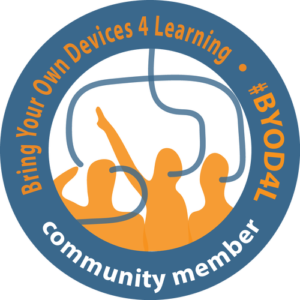I’ve been so preoccupied for the last year or so that I’ve had little time to engage in social networking or any open learning/reflecting. However, at the start of the week I happened to notice Sheila McNeil’s blog post extolling the benefits of participating in an open learning event called BYOD4L. She says “it brings people together to share practice […and] it’s a great way to reflect on how your own use of technology has evolved”. So, I thought I’d make time and give it a go. I’m glad that I did because it made me realise just how drastically my use of technology has altered in line with my learning practices. I’ve transitioned from an open learner, someone who is comfortable connecting and learning in open networks, to a PhD research student whose time and effort is more directed inwards or within closed communities.

The #BYOD4l activities centered on the 4Cs: connecting; communicating; curating; collaborating and creating. They provide an interesting framework to reflect on the changes.
I would’ve said that I was pretty au-fait at using technology to connect, but Lord, you know the saying “use it or lose it”, well that’s what’s happened. What a performance I had on Monday night trying to figure out how to use TweetDeck for a Twitter chat. This can’t be right. Then I remembered, I used to use Hootesuite with its dashboard configured like NASA control center to stream a gazillion Twitter hashtags and lists. It was like finding old friends, all those streams of conversations on familiar topics 🙂
In terms of communicating, I haven’t blogged regularly about my learning for ages. It’s not that I haven’t been writing; it’s just that I’ve been writing for a select audience of supervisors, and it just doesn’t seem to be stuff that warrants a blog post. I wish I hadn’t fallen out of the habit of blogging so regularly because I now feel that a large part of my learning journey will go uncaptured and it’ll be tricky to see the rationale (or lack of) for how things have developed.
The tools I primarily use for communicating at the moment seem to be Slack and Facebook groups. Both have been excellent in terms of facilitating essential peer support. BTW, there was an interesting discussion about Slack as a teaching and learning platform, due to its easy affordances of channels and messaging.
Could Slack Be the Next Online Learning Platform?
Slack app at University of Southampton
The topic of curating was an interesting reflection because the course listed a whole pile of content curation tools, most of them that I’ve used to a greater or lesser extent at one time or another. What struck me though was that the primary curation I do now is curating bibliographic references, for myself. I use Zotero, which is open source, and although it has the option to share your reference library, I haven’t actually done this. I might do in the future.
Collaborating is not really where I’m at at the moment. My primary focus is to develop a solid PhD research proposal, and that’s not a team sport.
The final C is creation. The BYOD4L course suggests that you create an artefact about your learning using a tool that you haven’t used before. Well, I cheated. I thought I’d use a tool I haven’t used in ages instead- my blog. And I’m glad that I did. And I’m glad that I joined BYOD4l this week as I’ve enjoyed hanging back out in the open – connecting and learning. It’s made me realise
I’m an open learner. Get me back out there!!!

This work is licensed under a Creative Commons Attribution-ShareAlike 4.0 International License.

